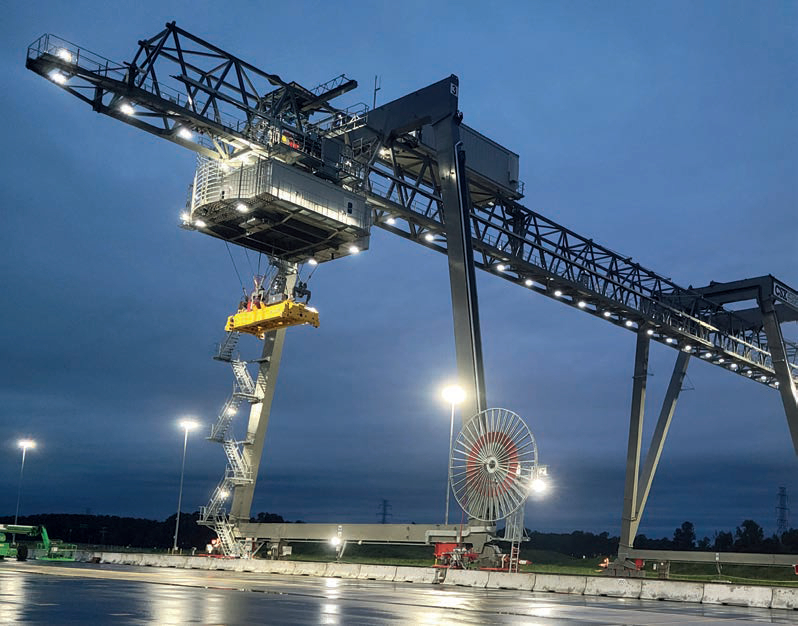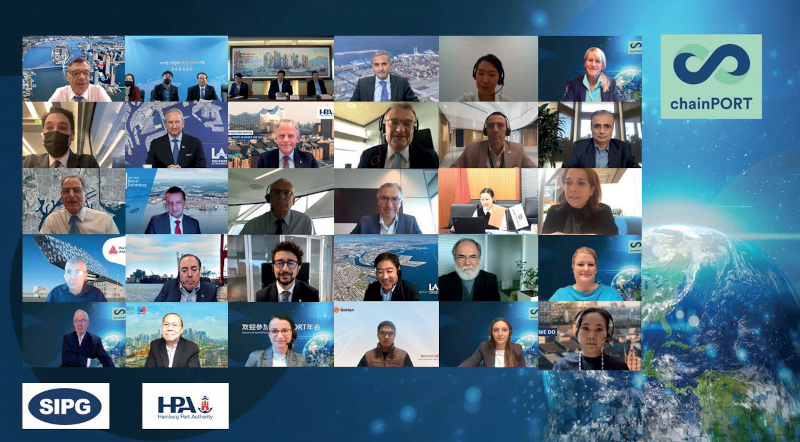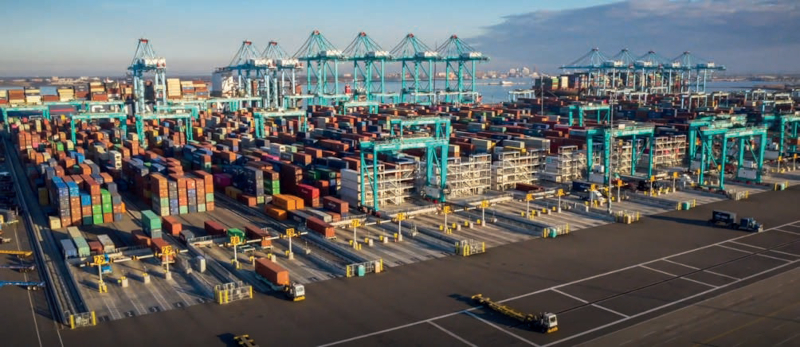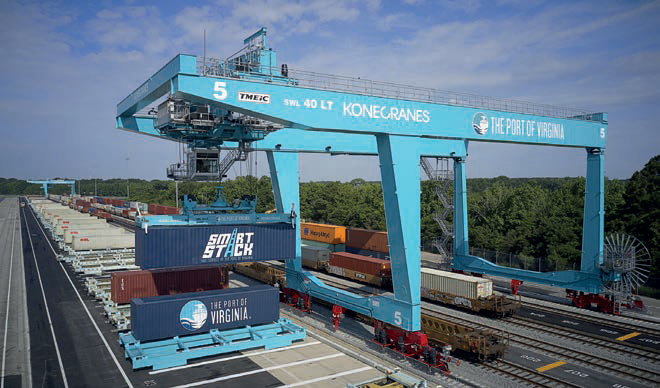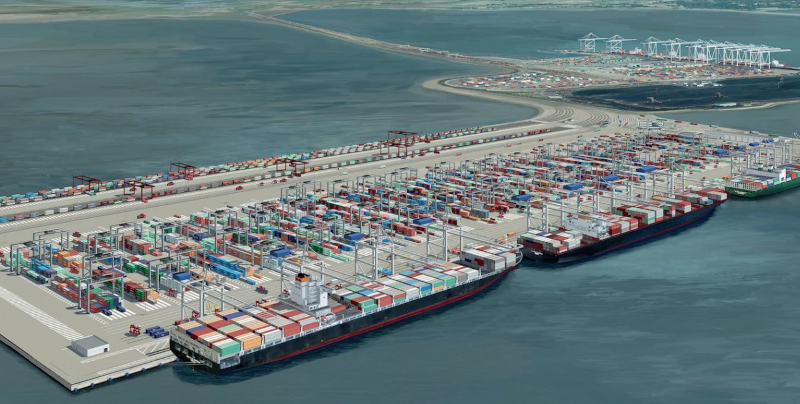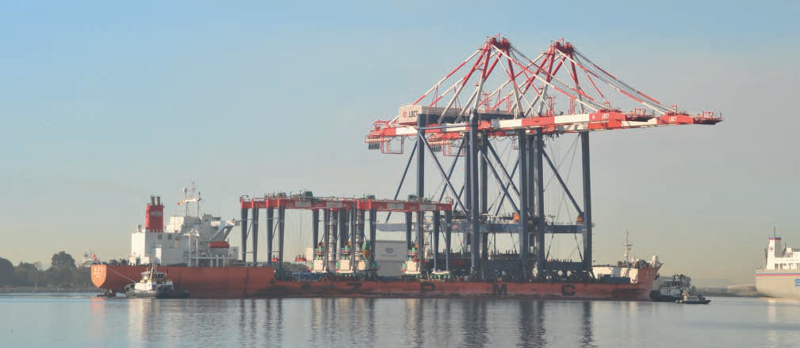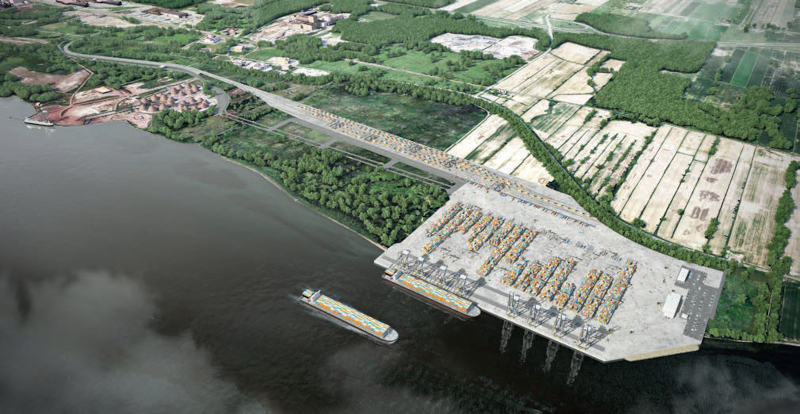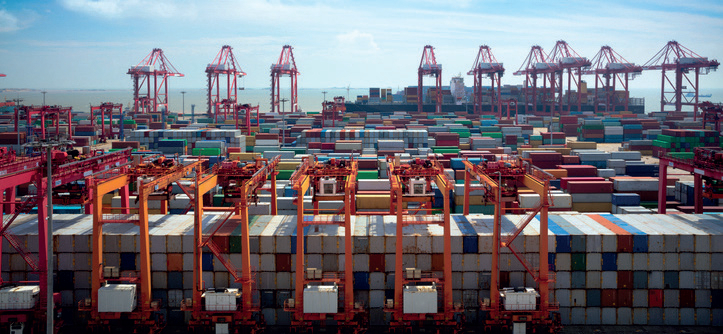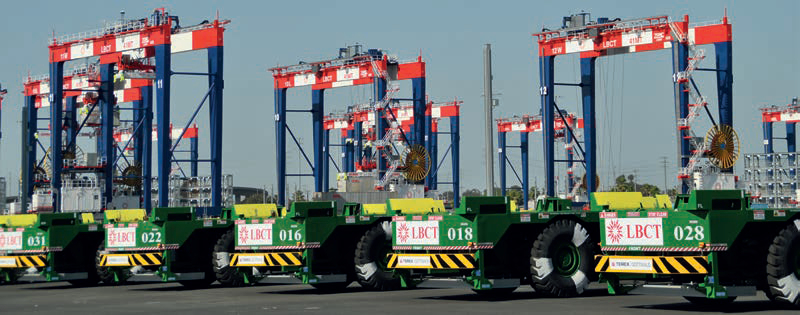Dawn of a new age
9 March 2022With the increase in the size of container ships worldwide, the push for automation across North America’s ports is gaining momentum. Tom Peters investigates.
The move toward automation at North American marine container ports is not progressing at a rapid rate, it appears to be in a slower, step-by-step mode.
By the end of 2020 it was reported there were approximately 50 automated or semi-automated container terminals globally. The United States reportedly had four but that number was expected to grow slightly.
With the increase in the size of container ships the world has been seeing in recent years, including several new vessels now surpassing 24,000 TEUs (20 foot equivalent units), it would seem the push for automation in North America would be gaining stronger momentum. Afterall, automation is being touted as the route to higher efficiency and safety when it comes to moving the ever-increasing number of containers over North American terminals. Other countries are already moving quickly in the automated direction.
For example, in September last year, presidents, CIOs (Chief Information Officers), and head strategists of 15 of the world’s leading ports convened digitally for the seventh annual chainPort meeting where automation was front and centre.
At the conference the participants not only exchanged professional advice but hands-on knowledge, which included intellectual insights and practical experience on new technologies that drive efficiency in daily port operations, solutions from the maritime sector, on how to strengthen supply chain resilience, and circular economy-related approaches to sustainability in ports.
Huang Heng, MD, Port Technology, Nezha Shipping, introduced a pioneering project about optical networking technology for centralized remote control in ports.
This endeavour, in the operation of next-generation smart ports, has been implemented in partnership with Shanghai International Port Group (SIPG) and Huawei. Kilometres away from the heart of the port, remote operators can control a variety of heavy port equipment at multiple locations from a single point. This has numerous advantages, such as increased efficiency in terminal operations, reduced commute times for staff, better predictability of personnel availability and increased attractiveness of the workplace.
The introduction of this technology goes hand-in-hand with a change in the profile of the future port workforce and the skills that will be needed in ports.
So, why have North American container ports not pushed forward and employed the new technology?
Dr. Jean-Paul Rodrique says it is a “very complicated question.” The Canadian scholar and professor in the Global Studies and Geography Department at Hofstra University, Hempstead, New York, is also a transportation expert and co-author of ‘Port Economics, Management and Policy’, with marine transportation experts Prof. Theo Notteboom, the University of Ghent and the University of Antwerp and Prof. Athanasios Pallis, from the University of Athens.
Dr. Rodrigue says for North American ports the automation question is “a very complicated one because automation obviously is a conversion of several issues.”
“What we have noticed is that in other parts of the world where there is a new terminal or a new expansion taking place, automation presents a good opportunity to take place at the same time as the renovation or expansion, while in North America the only new terminal we have seen recently is the one in Virginia, which is automated,” he explains.
Joe Harris, VP, communications and spokesman for the Port of Virginia, adds: “We have been successfully operating a semi-automated rail-mounted gantry crane operation at Virginia International Gateway (VIG) and Norfolk International Terminals (NIT) for some time now. We are also running a semi-automated CRMG (Cantilever Rail-Mounted Gantry Crane) operation at the VIG rail yard and are getting ready to break ground to create a semi-automated CRMG operation at NIT.”
Harris said going forward, Virginia will: “continue to leverage technology to our advantage where appropriate. The result is a modern, efficient operation. This efficiency is to the advantage of the customer, ocean carrier and cargo owner.”
Following Prof. Rodrigue’s comment on adding automation when building a new terminal or expanding an older one, there are two ports in Canada that are taking advantage of this situation.
The Montreal Port Authority (MPA) has been planning the addition of the Contrecoeur Terminal, where some degree of automation is anticipated.
“The Contrecoeur Terminal will be managed by a private partner using a Design-Build-Finance-Operate-Maintain (DBFOM) approach. The procurement process is currently taking place and will be completed by mid-2023. The operating parameters will, therefore, be determined by the private partner. This being said, the Contrecoeur project aims to install a modern and innovative infrastructure,” said Renee Larouche, director, comms, MPA.
At the Port of Vancouver, automation appears to be in the future of the proposed Roberts Bank Terminal 2 Project, which is undergoing an environmental assessment process and requires federal approval and other permits before construction can begin, says Efrosini Drimoussis, director, RBT2 infrastructure procurement for the Vancouver Fraser Port Authority.
“We assume the Roberts Bank Terminal 2 Project will be partially automated, similar to other newer terminals around the world. However, the final configuration of the terminal, including the level of automation, will be largely up to the new terminal operator,” Drimoussis says.
He adds the port authority: “anticipates that the terminal operator procurement will begin after the start of the landmass construction (mid-2020s).”
The anticipated levels of automation for the various terminal components at Roberts Bank include; ship-to-shore cranes operated manually and possibly remotely, automated stacking cranes, and manual and remote operated Intermodal yard (Rail Mounted Gantry Cranes). The terminal operator will have the flexibility to develop a terminal layout and operating concept that may have a greater or lesser degree of automation than what is currently assumed.
Also on Canada’s West Coast, some form of automation may be in line for Global Container Terminal’ s (GCT) Deltaport Expansion Berth 4 project. The project is undergoing a comprehensive, multiyear regulatory environmental impact assessment process.
“At this time, we cannot provide specific details regarding the container handling equipment specifications. This detail will be developed as the project advances during the coming years. As with previous successful projects at GCT Canada, such as the GCT Deltaport Intermodal Rail Yard Expansion Project we have a history of working with ILWU (International Longshore and Warehouse Union) partners regarding semi-automation technology,” said Jennifer Perih, GCT’s manager, corporate affairs.
The Port of Long Beach (POLB), California, has one automated container terminal, Long Beach Container Terminal (LBCT). Its final phase of construction was completed in 2021 and it has a capacity of up to 3.5 million TEUs a year. POLB has six container terminals and no other automated terminals are planned at this time, says port spokesman, Lee Peterson.
The LBCT has three berths and 14, ship-to-shore gantry cranes, about 80 guided vehicles, which carry the containers between the ship-to-shore gantry cranes, and the container yard. It has an extensive on-dock rail capacity.
LBCT during the planning process for the terminal, before the start of construction, opted for an automated terminal design.
However, Prof. Rodrigue said many terminal operators are reluctant to automate because they are not convinced there will be a good return on investment and the costs to automate are high. Also, if the decision is made to upgrade to automation, terminal operators are looking at shutting down 25% of their capacity and ‘that is the last thing you want to do these days’. So that is an issue. What is also a factor in the North American automation issue is labour opposition to modernization.
Prof. Rodrigue says he is not too sure to what extent labour is an issue: “but I think it is significant. Obviously, just the talk of it (automation) creates labour disputes and instability and, therefore, terminal operators are excessively reluctant to embrace automation because they know the minute they consider this project, they will have problems with labour. It could lead to labour shortages, not necessarily strikes but issues.” Therefore, he says, in North America automation becomes a last resort.
However, the professor suggests that building a new automated terminal provides some opportunity to deal with the labour issue in a positive way
“Where it is a new facility you (the terminal operator) has much more leeway because you have to negotiate a new contract, but while you are an existing terminal, you have to deal with the existing contract,” he says.
However, the US ILA (International Longshoremen’s Association) has taken a major stand against automation.
ILA president Harold Daggett, in a statement to the International Longshore and Warehouse Union (ILWU) at the start of an ILWU convention last summer, became very emotional in stating his case against automation and said dockworkers around the world are confronting the threat of automation and “automation means the elimination of jobs forever.”
Daggett said companies say automation will enhance competition and safety but all they want to do is eliminate jobs., he said.
He pledged ILA support in the fight against these companies and against automation, adding: “We will fight this for 100 years and never give in to automation.”
He said if any companies are planning to utilize autonomous container cargo ships without crew, ‘don’t sail them into ILA ports from Maine to Texas, Puerto Rico and Eastern Canada, because they won’t be unloaded or loaded by ILA members’.
Further to this are reports that Norway and Japan are developing and testing autonomous container vessels.
“The ILA will not work a container ship without a crew aboard,” said Daggett.
“Already one company developing these automated ships also plans for automated loading and unloading of cargo from these crewless ships without workers. That’s not going to happen under my watch.”
The current ILA contract expires in three years and Daggett says he will continue to keep his members protected from the threat of automation.
Currently, in the Port of Long Beach and the Port of Virginia, their automated facilities and equipment have not caused any labour issues.
ILWU members at the Port of Long Beach drive the ship-to-shore and rail cranes and members work in the control centre overseeing the other equipment. ILWU members also work as technicians for the equipment, says Peterson.
Harris says the Port of Virginia has “had really good, productive labor relations with our union for decades and we don’t foresee this relationship changing. Our labor partner has embraced the move into the technology age and based on our productivity in 2021, it shows: 3.5m TEUs processed in 2021, an increase of nearly 30% or 700,000+ TEUs (vs. 2020). “The ILA here is very progressive, and it understands that a well-trained, knowledgeable labor force combined with state-of-the-art technology, facilities, modern equipment help to build businesses to the benefit of everyone,” Harris said.
The Port of Wilmington, North Carolina is getting a side door push into automation. CSX Railway recently opened the $160 million Carolina Connector, the newest intermodal terminal on the CSX network.
Strategically located northeast of Raleigh, N.C., with easy access to Interstate 95, the terminal will relieve port and highway congestion by adding rail-to-truck transfer capacity for domestic and international container shipments.
The automation for the rail terminal, with its connection to the port, comes from Liebherr Container Cranes, which has supplied three, fully-automated Rail- Mounted Gantry cranes (RMG) to the CSX terminal in Rocky Mount. The cabinless RMGs also include Liebherr Remote Operator Stations (ROS).
The Liebherr RMGs have a span of 165ft. (50.292 m), a lift height over rail of 50ft. (15.24 m) and cantilevered outreaches both sides with a safe working load of 40 long tons (40.6 tons). Within the span, the machines will work five rail lines and a four-high, five-wide container stack, with a further two rail lines under one of the cantilevers. Truck handling will take place under the other cantilever in a truck transfer area. Container handling on the stack is fully automated and in line with terminal safety procedures, picking and placing from the rail cars is carried out remotely.
The RMGs will operate on both domestic 53’ wide top pick containers and ISO containers, handling single and double stacked rail cars.
At the end of the day, the writing is on the wall, automation will happen, says Prof. Rodrigue. The labour issue will require collaboration with the American unions. If automation doesn’t happen at some point. he suggests there will be a loss of revenue, a loss of productivity and a loss of cargo.
“It (automation) will take place as long as there is a clear issue of productivity and you want to keep social peace with your workforce,” he said.
Automation at North American ports also has a friend in the technology world.
“Automation throughout North American ports is building momentum. Terminal operators are genuinely interested in delivering value to their stakeholders through continuous improvement and investment in technology where it fits,” says Hugh Gallagher, VP, Customer Success, Marine, Tideworks Technology, Seattle.
“Automation won’t look the same for every facility or region, and it’s up to terminal operators to consider what is best for their terminal,” Gallagher said.
“The right solutions are based on specific terminal throughput, location and the needs of the port community.
“We have partnered with a number of terminal operators to assess how automation fits within their operations and have supported our customers with various automation initiatives. As the global supply chain continues to embrace automation and other emerging technologies, terminal operators will continue to look toward solutions that meet customers changing preferences and scale to their operations,” he added.”
